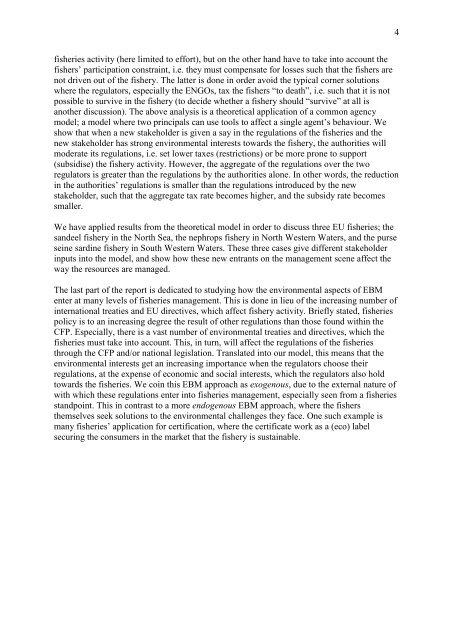Operational tools and adaptive management
Operational tools and adaptive management
Operational tools and adaptive management
You also want an ePaper? Increase the reach of your titles
YUMPU automatically turns print PDFs into web optimized ePapers that Google loves.
fisheries activity (here limited to effort), but on the other h<strong>and</strong> have to take into account the<br />
fishers‟ participation constraint, i.e. they must compensate for losses such that the fishers are<br />
not driven out of the fishery. The latter is done in order avoid the typical corner solutions<br />
where the regulators, especially the ENGOs, tax the fishers “to death”, i.e. such that it is not<br />
possible to survive in the fishery (to decide whether a fishery should “survive” at all is<br />
another discussion). The above analysis is a theoretical application of a common agency<br />
model; a model where two principals can use <strong>tools</strong> to affect a single agent‟s behaviour. We<br />
show that when a new stakeholder is given a say in the regulations of the fisheries <strong>and</strong> the<br />
new stakeholder has strong environmental interests towards the fishery, the authorities will<br />
moderate its regulations, i.e. set lower taxes (restrictions) or be more prone to support<br />
(subsidise) the fishery activity. However, the aggregate of the regulations over the two<br />
regulators is greater than the regulations by the authorities alone. In other words, the reduction<br />
in the authorities‟ regulations is smaller than the regulations introduced by the new<br />
stakeholder, such that the aggregate tax rate becomes higher, <strong>and</strong> the subsidy rate becomes<br />
smaller.<br />
We have applied results from the theoretical model in order to discuss three EU fisheries; the<br />
s<strong>and</strong>eel fishery in the North Sea, the nephrops fishery in North Western Waters, <strong>and</strong> the purse<br />
seine sardine fishery in South Western Waters. These three cases give different stakeholder<br />
inputs into the model, <strong>and</strong> show how these new entrants on the <strong>management</strong> scene affect the<br />
way the resources are managed.<br />
The last part of the report is dedicated to studying how the environmental aspects of EBM<br />
enter at many levels of fisheries <strong>management</strong>. This is done in lieu of the increasing number of<br />
international treaties <strong>and</strong> EU directives, which affect fishery activity. Briefly stated, fisheries<br />
policy is to an increasing degree the result of other regulations than those found within the<br />
CFP. Especially, there is a vast number of environmental treaties <strong>and</strong> directives, which the<br />
fisheries must take into account. This, in turn, will affect the regulations of the fisheries<br />
through the CFP <strong>and</strong>/or national legislation. Translated into our model, this means that the<br />
environmental interests get an increasing importance when the regulators choose their<br />
regulations, at the expense of economic <strong>and</strong> social interests, which the regulators also hold<br />
towards the fisheries. We coin this EBM approach as exogenous, due to the external nature of<br />
with which these regulations enter into fisheries <strong>management</strong>, especially seen from a fisheries<br />
st<strong>and</strong>point. This in contrast to a more endogenous EBM approach, where the fishers<br />
themselves seek solutions to the environmental challenges they face. One such example is<br />
many fisheries‟ application for certification, where the certificate work as a (eco) label<br />
securing the consumers in the market that the fishery is sustainable.<br />
4

















